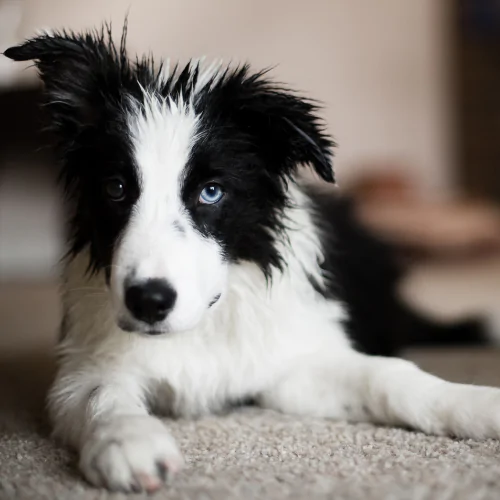
Fun canine enrichment ideas

Allie Simpson
25 September 2021 | 8 minutes read
We love a good reason to show our pooches some extra love and attention each and every day! Let’s jump in paws first and learn all about dog enrichment, why it’s important, and discover different ideas on how you can keep your canine happy.
Table of Contents
- What’s the meaning of canine enrichment?
- Why is enrichment important for your dog?
- What are the different enrichment activities for dogs?
> What is environmental enrichment for dogs?
> What is social enrichment for dogs?
> What is cognitive enrichment for dogs?
> What is nutritional enrichment for dogs? - Does age and breed matter for dog enrichment?
- DIY dog mental stimulation toys
> Other DIY dog toy ideas
What’s the meaning of canine enrichment?
*Pulls out the dog-tionary* – canine enrichment is all about making your dog’s life richer. We’re talking about interactions or activities that are mentally and physically stimulating. If you want your dog to be less stressed, less destructive, and generally happier, you can bring in some canine enrichment.
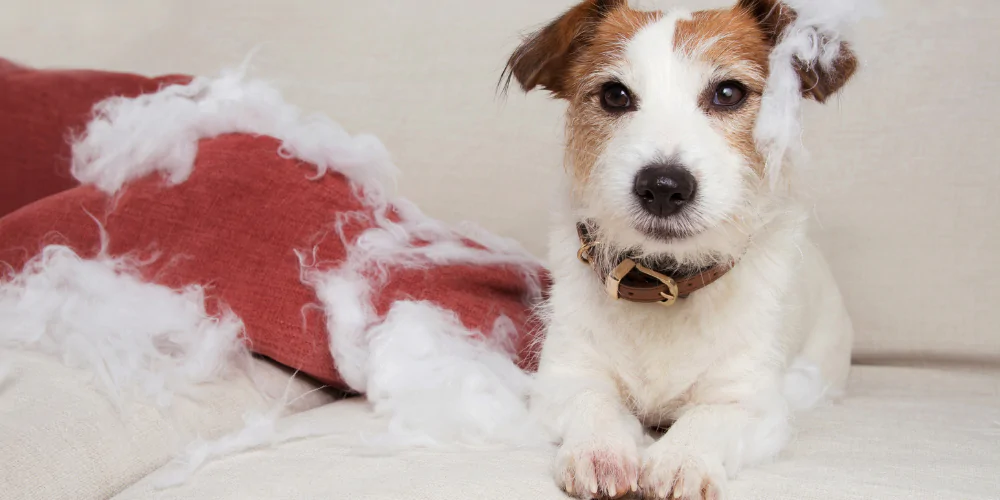
Why is enrichment important for your dog?
We’re barking mad for canine enrichment. It can help with socialisation and keeping their mind active, leading to a happier and healthier life for them. Imagine if you were stuck doing nothing all day – you’d likely feel gloomy, bored, and possibly tempted into doing something mischievous!
Take a walk on the wild side and you’ll find untamed canines in nature who are constantly stimulated by their environment. From hunting and foraging to exploring new places with their packs, there’s plenty to keep them occupied in the wild. Although you can’t perfectly replicate this setup for your domesticated pooch, we’ve got plenty of ideas for at-home canine enrichment.
More positives of stimulation and entertainment? They could become more relaxed, more confident, and even improve their problem-solving skills. Doing engaging activities with your dog is also a great bonding experience (and we don’t know about you, but we want our dogs to love us as much as possible).
What are the different enrichment activities for dogs?
Now we know the ‘why’, let’s jump into the ‘what’. To make things easier, we’re splitting up canine enrichment into four areas: environmental, social, cognitive, and nutritional. Don’t worry, we’ll break it down for you.
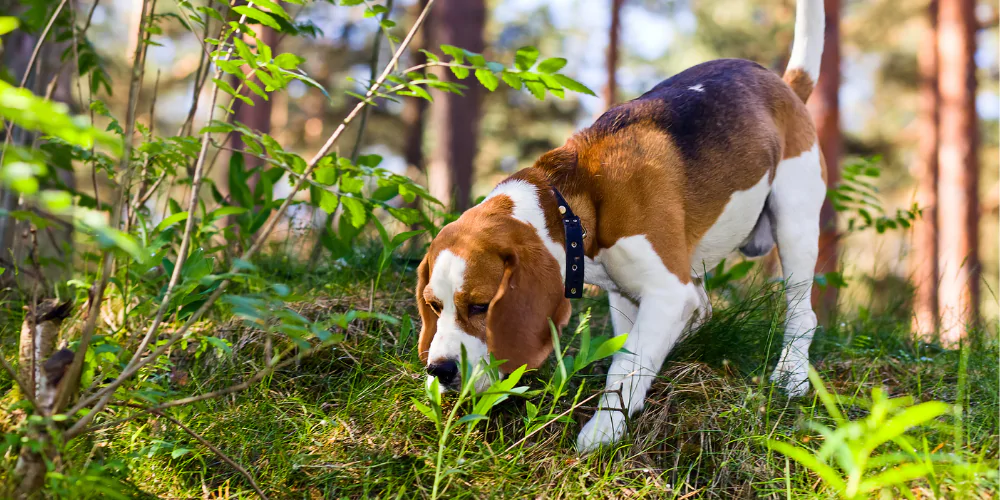
> What is environmental enrichment for dogs?
Environmental and physical enrichment is all about making your dog’s living space more exciting. Keeping them cooped in one particular area, limiting their physical activity or not giving them interesting objects to interact with could end in boredom and destruction. They say variety is the spice of life, and it couldn’t be more true when creating a fun space.
Our handy tip is to keep their senses in mind when looking to enrich their environment: touch, taste, sight, smell, and hearing.
A few fun suggestions for environmental enrichment are:
- Out with the old, in with the new – introducing a new toy will encourage curiosity, especially if they’ve been playing with the same ones for a long time.
- Toy rotation – select a couple of toys for your dog to play with and put the rest away. After a week, swap them out for a new group.
- Add a mirror – some dogs love to interact with their reflection, so try adding a (secured) mirror to their line of sight.
- Explore new places – take your dog on different walking routes so they can explore new areas and experience unique sights and sounds.
- Digging pit – invest in a play pool or pit and fill it with sand, dirt or plastic balls. You can then hide their favourite toys and treats to sniff out and dig up.
- Sensory garden – create a dog-friendly outdoor space with bright plants and flowers that will intrigue their senses.
- Travel – there are lots of dog-friendly hotels and cottages around the UK, so why not take your pup away with you?
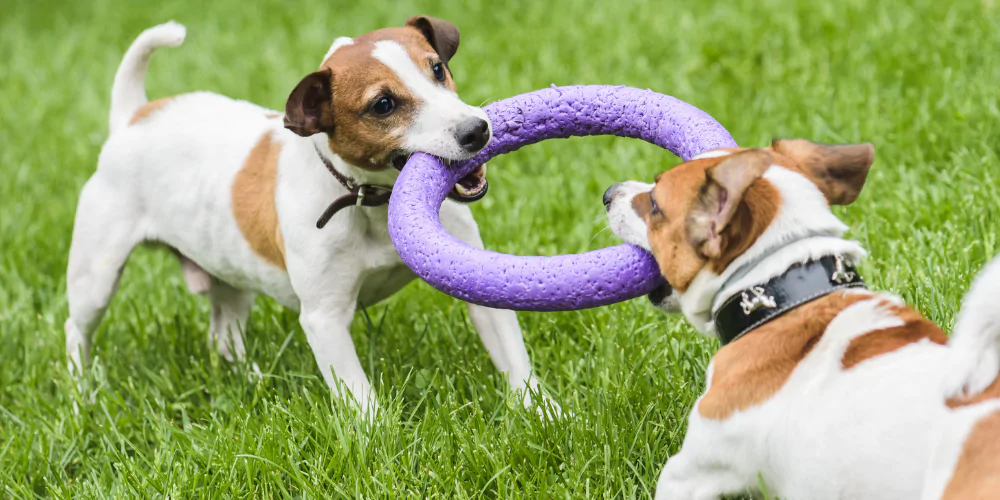
> What is social enrichment for dogs?
Dogs are highly social creatures (sneaking into your bed in the morning, anyone?) and love to be with their humans. This is why proper socialisation is an important part of canine enrichment. Spending time with people and other dogs will build up their confidence and trust, plus keep them engaged and happy.
If your dog hasn’t had proper training or is reactive around other dogs, these kinds of interactions may be stressful or triggering. Consider working with a trained behaviouralist or consulting with your vet.
Some examples of fun ways to socially enrich your canine are:
- Regular walks – daily walks help your dog stay active and healthy, but they also allow them to interact with other people and pooches.
- Group walks – if your dog has a strong pack mentality, try arranging a group walk and see how they like it.
- Dog parks – take them to a dedicated park where they can safely mix with other dogs in an enclosed space. Don’t forget to watch your dog and keep park etiquette in mind.
- Playtime – don’t just leave your dog with their toys, engage in play! Many pooches love a good ol’ tug of war or game of fetch.
- Playdates – if a dedicated park isn’t to your dog’s taste, arrange to meet up with a doggy friend instead.
- Daycare – a licensed and insured doggy daycare could be a way for your dog to mix with other canines in a controlled setting.
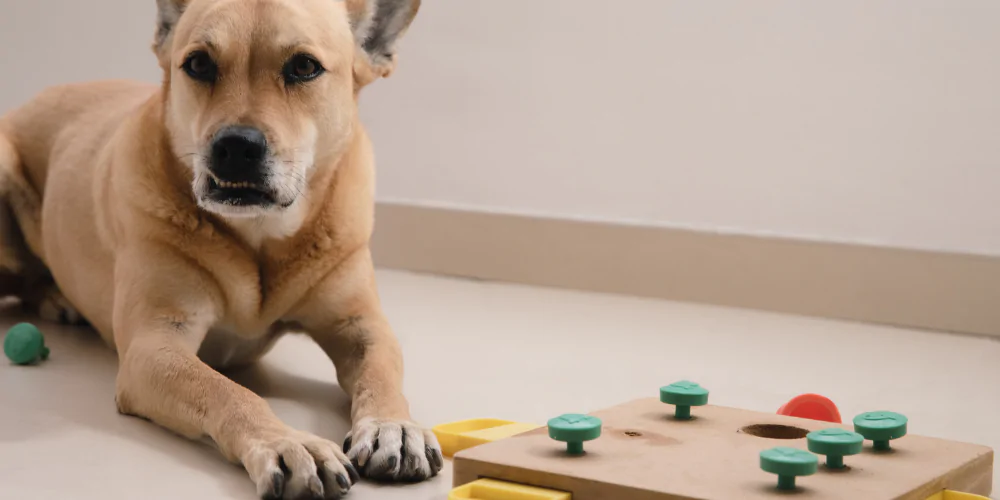
> What is cognitive enrichment for dogs?
Exercising your dog’s mind is just as important as keeping their body active, which is where cognitive enrichment comes in. Think about activities that encourage them to use multiple senses, to test their problem-solving skills or to put their natural breed instincts to work. And remember, it’s never too late to teach an old dog new tricks!
Some fun ideas for cognitive enrichment include:
- Toys – from wooden to plastic, rope to fabric, there’s plenty of choice out there for your dog. Some are soft for comfort, others have squeakers to excite. Make sure the material is dog safe and check regularly for wear and tear, removing when needed.
- Puzzles – these can keep your pooch occupied for hours with the potential for a tasty reward if solved!
- Hide and seek – you can’t beat a classic game of hide and seek. Your dog can use their sense of smell and hearing to find you in the house or garden.
- Hide and seek, take two – you can also hide a favourite toy or treat around the house and garden. Scent work is great for hounds as it works to their natural instincts.
- Fetch – another classic, some dogs will chase and return a ball for hours on end. Throw it far enough and they may have to use their skills to hunt it down.
- Training – from basic commands to more complex tricks, your dog will enjoy learning new things (and hopefully become obedient!). Stick to short bursts to stop boredom.
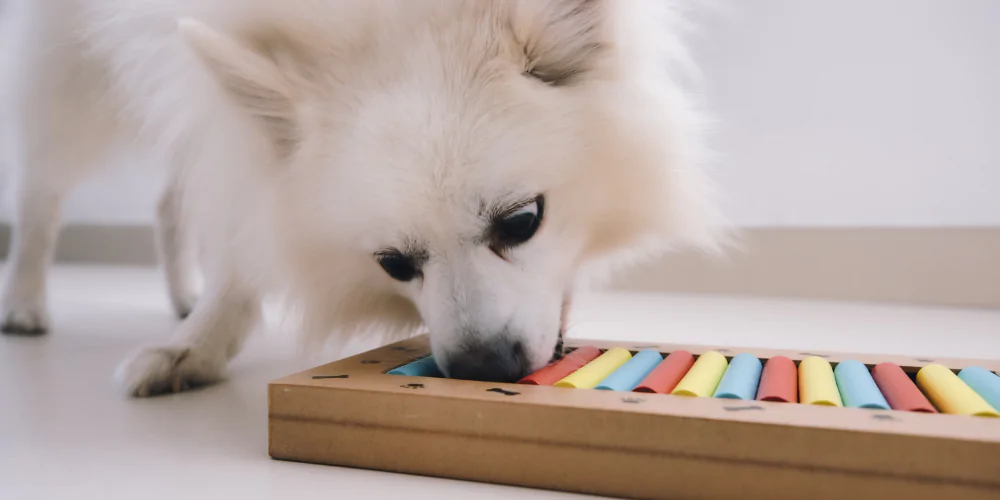
> What is nutritional enrichment for dogs?
Also known as ‘give me all the treats’… just joking, don’t overfeed your dog. Seriously though, you may want to introduce your dog to some food-based enrichment to encourage their foraging skills. It also helps to get them moving that little bit more. If your canine is especially motivated by food, we reckon they might just enjoy these suggestions.
Our pick of fun nutritional enrichment ideas are:
- Destruction boxes – many dogs love to dig around in a cardboard box that’s filled with toys that have been stuffed with treats.
- Interactive feeders/ dog puzzle toys – making your pup work harder for their kibble and bust boredom with interactive feeders and puzzle toys.
- Stuffed toys – rubber toys like Kongs can be packed with treats such as peanut butter and dog-friendly paste then frozen to create a longer-lasting treat.
- Snuffle mats – get that cute snoot to work and encourage your dog to sniff out treats hidden in the strands of a snuffle mat.
- Scatter feeding – instead of putting their food in a bowl, try scattering their kibble around the room (if not too messy) to make them work that bit harder for dinner.
Does age and breed matter for dog enrichment?
Absolutely. We have a lot of love for our senior dogs, but while they may be young at heart, their bodies can’t always keep up, and that’s OK. We don’t want anyone getting injured here! Just adapt the enrichment to suit them. You could try setting up an older canine next to a window where they can act as a neighbourhood watchdog.
This ‘adapt to suit’ mindset is equally true for puppies. Little bodies that are full of beans, puppies often need extra enrichment to satisfy their inquisitive natures and high energy. Translation? You might need to up the activity ante for these little rascals.
An anxious dog might need more calming gamings or sensory activities to help ease their worry. Breeds that are used for herding or hunting could want something a bit more mentally challenging or that burns more energy.
What we’re trying to say is, always think about your dog’s specific needs as there’s no ‘one-size fits all’ approach to enrichment.
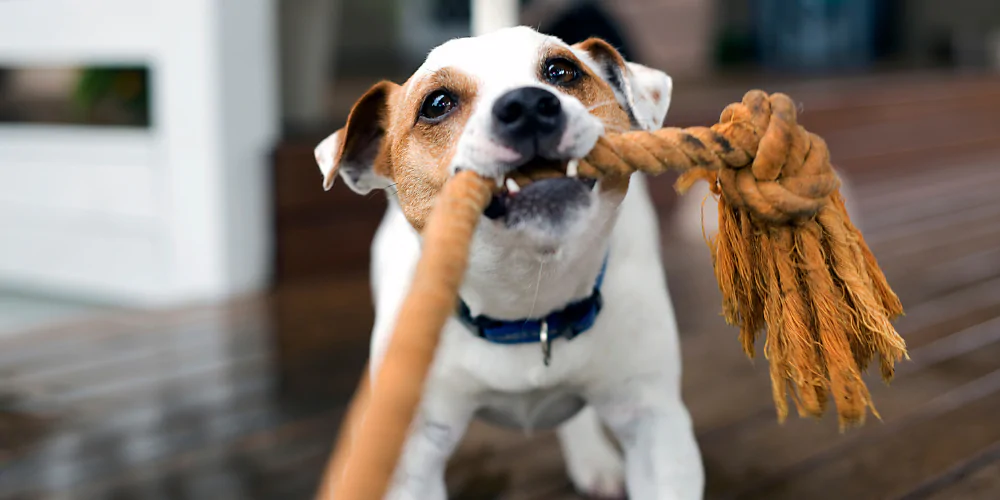
DIY dog mental stimulation toys
Many of us love a bit of DIY, but why keep this just to improving the home?
Snuffle balls and mats are great dog mental stimulation toys and have grown in popularity over the years. You can buy them online and even in some pet stores. If you’re a creative pet parent, you can try making your own at home.
> Other DIY dog toy ideas
A plastic bottle or cardboard tube is a quick and easy way to make an enrichment game for your dog. Pop kibble into a loo roll and squish down the ends to trap the treats, then watch your dog chew and scratch their way inside. We think they’ll also be thoroughly entertained by rolling a treat-filled plastic bottle around the room.
We all want our dogs to lead happy and fulfilled lives. Our lifetime cover dog insurance can give you peace of mind that your dog is covered when they’re not feeling so perky.


